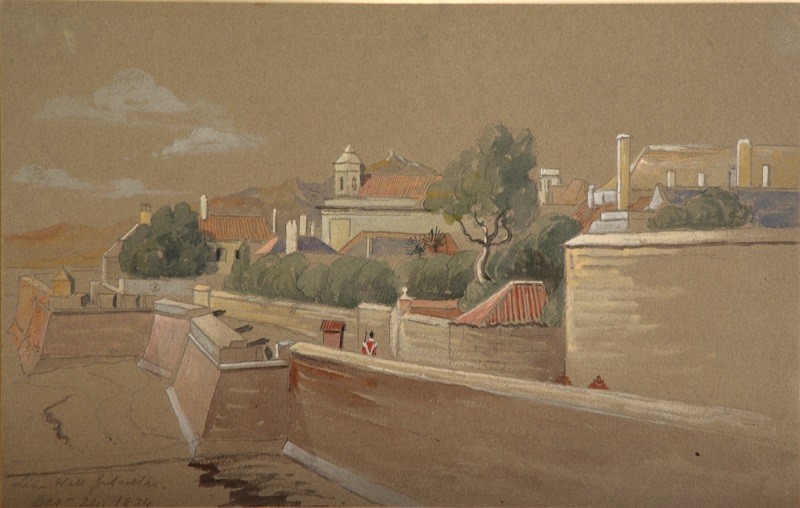Booth’s diaries

Virtual Museum: Military History
Booth’s diaries
Continuing with William Booth's diary...
"Town sea line between Waterport and South Bastion consists of several Batteries built without any regular form. ‘Tis mounted with 44 pieces of cannon of different natures and defends the Front of the Town towards the Sea, which has besides a natural defence of rocks lying between high and low water and extending 3 or 400 feet out the whole length of the Town, which makes the landing on that part extremely difficult.
The Town has nothing in itself remarkable neither Churches nor buildings being worthwhile taking notice of; the Fountain on the Parade which supplies the Town with water excepted, as it is supplied from rain which is collected in the season into a vast bank of sand on the South of the Town situated on the declivity of the mountain in which there has been lay’d a number of channels of brick one foot high and four inches wide to receive it, from thence into the reservoir of two feet four inches broad and two feet deep.
South Bastion, at the extremity of the Town line, ‘tis also the Bastion of the Front which encloses the place towards the South. Its faces are irregular, that next the Sea being 300 feet in length and mounted with 13 twenty four pounders, the other is 260 feet and is raised higher in order to cover and secure the sand hills immediately in front and within musquet shot, it has two guns mounted and in the exercising place for the mortars.
The flank is covered by a small epaulement; and the retired flank has two embrasures for scouring the ditch and the curtain in which the Southport Gate is built after the ancient manner, and has loop holes for wall pieces to defend between the outward and inward gates, over which there are the Arms of the Empire and those of Spain, with two pillars wreath’d with the following inscription (PLUS ULTRA); the whole built by Charles the 5th then Emperor and King of Spain.
This Curtain is no more than 800 feet in length and has a large Flat Bastion constructed near the center, which makes the several flanks to be no more than 300 feet from each other; this Flat Bastion is made to augment the defence and protect the curtain from the high ground opposite to it, which obliged the Engineer to build high traverses of masonry which will prove very dangerous to those who are to defend within.
The flank next the South Bastion has also an epaulement. The communication is by a gate into the curtain and there is a retired flank next the bridge whose extremity on the side of the hill is covered by a demi-bastion which joins the precipice that continues until it breaks off to a pass where a wall is carried on to the summit of the mountain for preventing the coming into the town; above the work within this wall is the remains of one built by the Moors and seems to have been designed for the same intent.
The ditch was never finished and is made use of at present for a garden, the bridge is of solid masonry, its form is described from two different centers; there is no drawbridge at the scarp and counterscarp. This covertway is quite gone to ruin and its glacis is the burying ground for the soldiers."
Image: Line Wall, Gibraltar, 24th October, 1834. Watercolour by Lieutenant Frederick Leeds Edridge
Published: June 18, 2020
Other similar VM - Military History
VM - Military History
military history fraternising in gibraltar - an incident during the south african war (unknown artist)
Published: April 05, 2020
18-20 Bomb House Lane
PO Box 939,
Gibraltar
